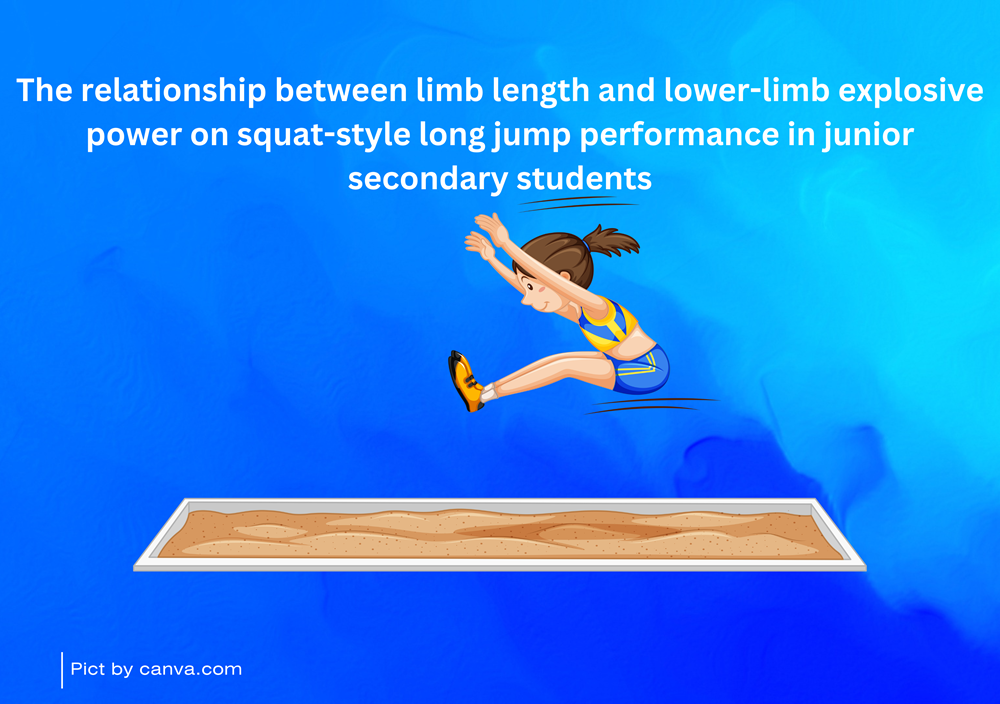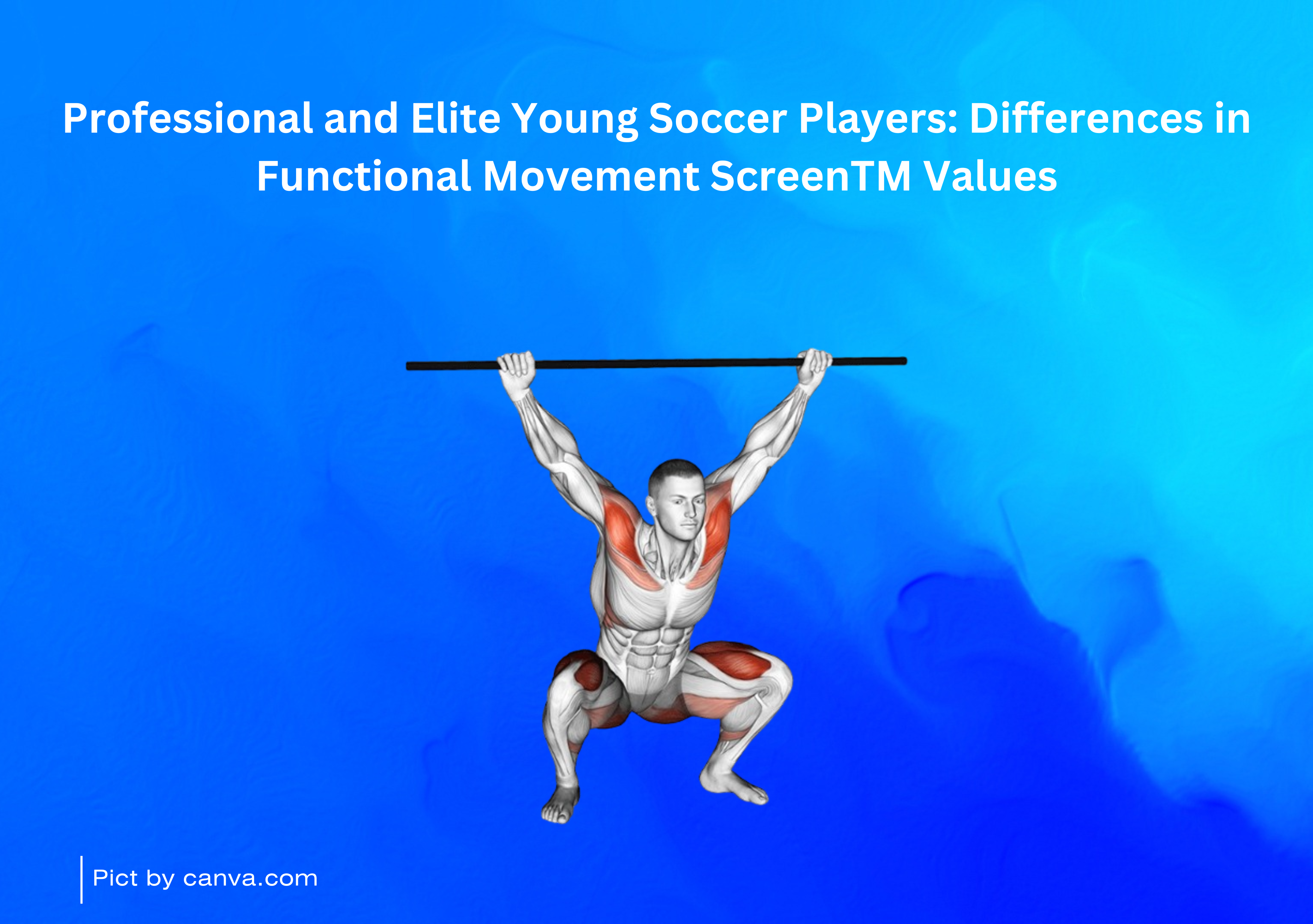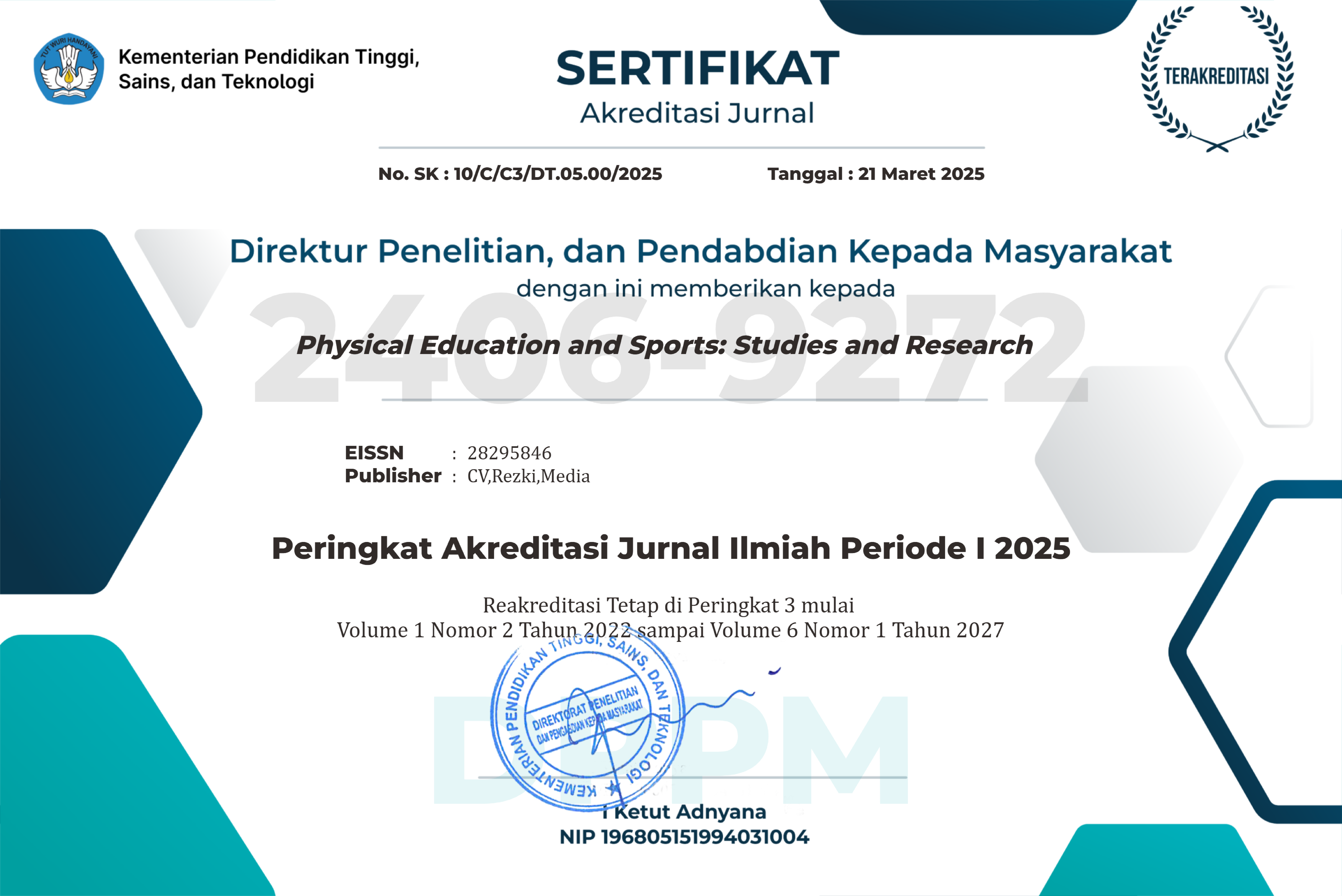The relationship between limb length and lower-limb explosive power on squat-style long jump performance in junior secondary students

Downloads
Background: To determine the relationship between leg length and leg muscle explosive power with squat style long jump performance applied to junior high school students.
Objectives: This study examines the relationship between leg length, leg muscle explosive power, and the ability to jump squatting style long.
Methods: The method used is a quantitative descriptive design with a correlational study. The study population amounted to 60 male students in class VIII. Sampling using the Purposive Proportional Systematic Random Sampling technique amounted to 45 students. The collected data were analyzed using three prerequisite tests: data normality test, homogeneity test, and linearity test. After fulfilling the prerequisite test requirements, it can be continued with 4 hypothesis tests, product moment test, multiple correlation test, regression equation line, and practical contribution and relative contribution.
Results: The data obtained using inferential statistics in multiple correlation analysis is complemented by multiple regression analysis. The results of the multiple correlation test obtained a coefficient = 0.687 and Sig. P = 0.001 < a = 0.05.
Conclusions: The study concludes a positive and linear relationship between leg length and leg muscle explosive power with squat-style long jump performance. Based on these findings, further research is recommended to explore additional variables such as speed, flexibility, and confidence, which may influence squat-style long jump performance.
Ardana, W. N., Adnyana, I. W., & Artawan, K. S. (2018). Korelasi Berat Badan Dan Kekuatan Otot Tungkai Terhadap Daya Ledak Siswa Putra Kelas Vii G Dan H Smp Wisata Sanur Tahun Pelajaran 2016/2017.Jurnal Pendidikan Kesehatan Rekreasi, 4(1), 22–26. https://ojs.mahadewa.ac.id/index.php/jpkr/article/view/127
Bompa, T. O., & Carrera, M. C. (2015). Periodization Training For Sports. http://books.google.com/books?id=RUowTe6UvbcC&pgis=1
Çıplak, M. E., Eler, N., Eler, S., & Acar, H. (2020). The Relationship Between Anthropometry and Jumping Performance in Handball. https://doi.org/10.23751/pn.v22i2.9721
Darlis, R., & Rahmadani, A. (2023). Kontribusi Daya Ledak Otot Tungkai dan Kecepatan Lari Terhadap Hasil Lompat Jauh Siswa Kelas VIII SMPN 6 Siak Hulu Kabupaten Kampar. Jurnal Pendidikan Terintegrasi, 3(2). https://core.ac.uk/download/pdf/595494920.pdf
Gunawan, E. (2023). Hubungan Daya Ledak Otot Tungkai Dengan Kemampuan Lompat Jauh Gaya Jongkok Pada Siswa SMP Negeri 02 Rumbia. JURNAL ILMIAH PENJAS (Penelitian, Pendidikan dan Pengajaran), 9(2), 287-300. https://doi.org/10.36728/jip.v9i2.3041
Haryanto, A. I., Liputo, N., & Fataha, I. (2021). Korelasi Panjang Tungkai, Power Otot Tungkai Dan Kecepatan Lari Dengan Hasil Lompat Jauh. Jambura Health and Sport Journal, 3(1), 42-50. https://doi.org/10.37311/jhsj.v3i1.9890
Hasbunallah, H. (2018). Hubungan Antara Panjang Tungkai Dan Daya Ledak Tungkai Dengan Kemampuan Lompat Jauh Siswa SMP Negeri 1 Balusu. SPORTIVE: Jurnal Pendidikan Jasmani, Olahraga dan Rekreasi , 1 (2), 67-75. https://doi.org/10.26858/sportive.v1i2.6391
Hasruddin, H. (2019). Kontribusi Daya Ledak Tungkai Dan Kecepatan Lari Dengan Kemampuan Lompat Jauh. Cendekia: Jurnal Ilmiah Pendidikan , 7 (1), 25-32. https://ejurnal.stkip-pb.ac.id/index.php/jurnal/article/view/116
Hermawan, I., & Tarsono, T. (2017). Hubungan Bentuk Telapak Kaki, Panjang Tungkai Dengan Daya Ledak Otot Tungkai Terhadap Atlet Kids Athletics Putri 11-14 Tahun Rawamangun. Journal Physical Education, Health and Recreation, 1(2), 25. https://ejurnal.ung.ac.id/index.php/jhsj/article/download/9890/2741
Irwandi, A., Karim, A., & Cakrawijaya, M. H. (2022). Kontribusi Kemampuan Fisik Terhadap Kemampuan Lompat Jauh Gaya Jongkok Siswa SMA Negeri 14 Makassar. Sportify Journal, 2(1), 17-24. https://doi.org/10.36312/sfj.v2i1.13
Ishak, M., Hakim, H., Sahabuddin, S., & Bismar, A. R. (2023). Lompat Jauh Gaya Jongkok:(Studi Korelasi Antara Panjang Tungkai & Kecepatan Lari). Jurnal Olahraga Kebugaran dan Rehabilitasi (JOKER), 3(2), 117-123. https://journal.unsika.ac.id/index.php/joker/article/download/10210
Iswanto, A., & Widayati, E. (2021). Pembelajaran Pendidikan Jasmani Yang Efektif Dan Berkualitas. MAJORA: Majalah Ilmiah Olahraga, 27(1), 13–17. https://www.academia.edu/download/96930134/pdf.pdf
Kardi, I. S., Ita, S., Hasan, B., & Sutriawan, A. (2022). Atletik: Kajian Mendalam untuk Optimalisasi Prestasi Lari Sprint. CV. Bintang Semesta Media. https://books.google.co.id/books?id=qhatEAAAQBAJ
Kurniawan, A., Haryanto, D., & Sukendro, S. (2024). Hubungan Antara Panjang Tungkai dan Daya Ledak Otot Tungkai Terhadap Kecepatan Lari 50 Meter. Cerdas Sifa Pendidikan, 13(1), 35–45. https://doi.org/10.22437/csp.v13i1.28155
Latuheru, R. V. (2019). Hubungan Antara Kelentukan Togok, Keseimbangan Badan, Dan Daya Ledak Tungkai Dengan Kemampuan Lompat Jauh. SPORTIVE: Journal Of Physical Education, Sport And Recreation, 3(1), 22-29. https://doi.org/10.26858/sportive.v3i1.16855
Lesmana, H. S., Ridwan, M., & Donie, D. (2020). Kelentukan dan Daya Ledak Otot Tungkai Terhadap Kemampuan Lompat Jauh Atlet Atletik. Jurnal Patriot, 2(3), 848–859. https://doi.org/10.24036/patriot.v2i3.675
Mustafa & Dwiyoga. (2020). Kurikulum Pendidikan Jasmani, Olahraga, dan Kesehatan di Indonesia Abad 21. JARTIKA Jurnal Riset Teknologi Dan Inovasi Pendidikan, 3(2), 422–438. https://doi.org/10.36765/jartika.v3i2.268
Muzakki, F. A., & Alficandra, A. (2023). Kontribusi Daya Ledak Otot Tungkai Dan Kecepatan Lari Terhadap Hasil Lompat Jauh Mahasiswa Penjaskesrek. Innovative: Journal Of Social Science Research, 3(5), 6226-6235. http://j-innovative.org/index.php/Innovative/article/view/5540
Purnomo, I. M., & Nurrochmah, S. (2023). Analisis Antropometri, Tingkat Kebugaran Jasmani dan Hasil Belajar Gerak Mahasiswa Angkatan 2022 Semester Gasal 2022/2023 PJKR-FIK-UM. Jurnal Segar, 12(1), 1–13. https://doi.org/10.21009/segar/1201.01
Rahyubi, H. (2017). Teori-Teori Belajar dan Aplikasi Pembelaaran Motorik. Deskripsi dan Tinjauan Kritis. Nusa Media. https://onesearch.id/Record/IOS3767.JATEN000000133029704
Ridwan, M., & Sumanto, A. (2017). Kontribusi Daya Ledak Otot Tungkai, Kecepatan dan Kelentukan dengan Kemampuan Lompat Jauh. Jurnal Performa Olahraga, 2(01), 69–81. https://doi.org/10.24036/jpo67019
Riyanto, A., Simanjuntak, V., & Haetami, M. (2018). Meningkatkan Hasil Belajar Lompat Jauh Gaya Menggantung Melalui Media Karet Gelang Pada Siswa SD. Jurnal Pendidikan dan Pembelajaran Khatulistiwa (JPPK), 7(1).
Sapwaturrahman, S., Kesuma, D. W. C. W., & Syarifoeddin, E. W. (2021). Hubungan Panjang Tungkai Dan Daya Ledak Otot Tungkai Dengan Prestasi Lompat Jauh Pada Siswa Putra Kelas VII SMPN 1 Sumbawa. Gelora: Jurnal Pendidikan Olahraga dan Kesehatan IKIP Mataram, 7(1), 40-48. https://doi.org/10.33394/gjpok.v7i1.3350
Setyawati, V. A. V. & E. Hartini. (2018). Buku Ajar Dasar Ilmu Gizi Kesehatan Masyarakat. Yogyakarta: Deepublish Publisher, CV Budi Utama. Deepublish. https://repository.deepublish.com/publications/588569/buku-ajar-dasar-ilmu-gizi-kesehatan-masyarakat
Sugiyono. (2017). Metode penelitian bisnis: pendekatan kuantitatif, kualitatif, kombinasi, dan R&D. Penerbit CV. Alfabeta: Bandung, 225(87), 48-61.
Sukirno, S., & Pratama, R. R. (2019). Pengembangan model pembelajaran atletik berbasis permainan di sekolah dasar. Altius: Jurnal Ilmu Olahraga dan Kesehatan, 7(2), 110-121. https://core.ac.uk/download/pdf/267824381.pdf
Thapa, R. K., Chaware, U., Sarmah, B., Afonso, J., Moran, J., Chaabene, H., & Ramirez-Campillo, R. (2024). The effects of single and combined jump exercises utilizing fast and slow stretch-shortening cycle on physical fitness measures in healthy adult males: A randomized controlled trial. Montenegrin Journal of Sports Science and Medicine, 13(1), 65-74. https://doi.org/10.26773/mjssm.240308
Wahidi, R., & Nurcahya, Y. (2019). Hubungan Antara Panjang Tungkai Dengan Hasil Lompat Jauh. Jurnal Kepelatihan Olahraga, 11(1), 59–67. https://doi.org/10.17509/jko-upi.v11i1.16827
Wilkinson Maden, T. M., Balshaw, T. G., Massey, G. J., & Folland, J. P. (2021). Muscle architecture and morphology as determinants of explosive strength. European Journal of Applied Physiology, 121(4), 1099–1110. https://doi.org/10.1007/s00421-020-04585-1
Yulmiando, R. (2020). Kontribusi Daya Ledak Otot Tungkai Dan Keseimbangan Terhadap Kemampuan Lompat Jauh Siswa Smp Negeri 1 Tembilahan. JOI (Jurnal Olahraga Indragiri): Olahraga, Pendidikan, Kesehatan, Rekreasi, 4(1), 156-170. https://ejournal-fkip.unisi.ac.id/joi/article/view/1410
Yusuf, F. I., & Rubiono, G. (2018, November). Analisis Matematis Prediksi Jarak Lompatan Atlet Lompat Jauh Berbasis Sudut Tolakan (Take-off). In Prosiding Seminar Nasional IPTEK Olahraga (SENALOG) (Vol. 1, No. 1, pp. 40-44). https://ejournal.unibabwi.ac.id/index.php/semnassenalog/article/view/187
Zikri, A. Z. A., Ramadi, R., & Juita, A. J. A. Hubungan Panjang Tungkai dan Kekuatan Otot Tungkai dengan Hasil Lompat Jauh Gaya Jongkok Siswa Kelas VII SMP Negeri 4 Pekanbaru (Doctoral dissertation, Riau University).
Copyright (c) 2025 Karina Octaviani, Siti Nurrochmah

This work is licensed under a Creative Commons Attribution-ShareAlike 4.0 International License.























